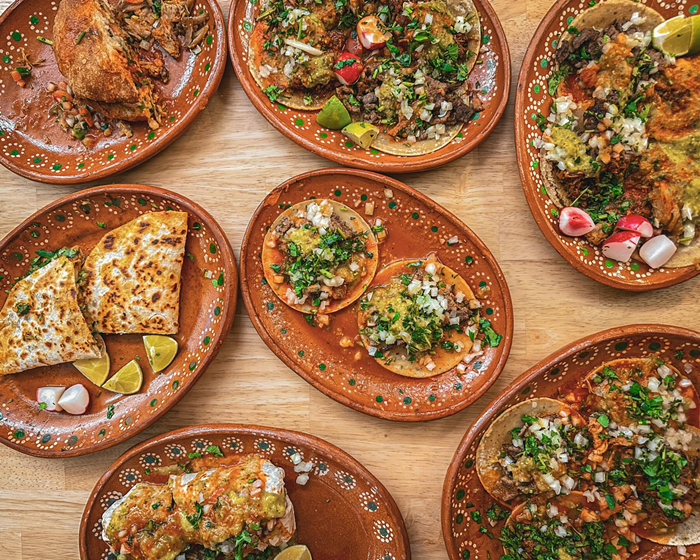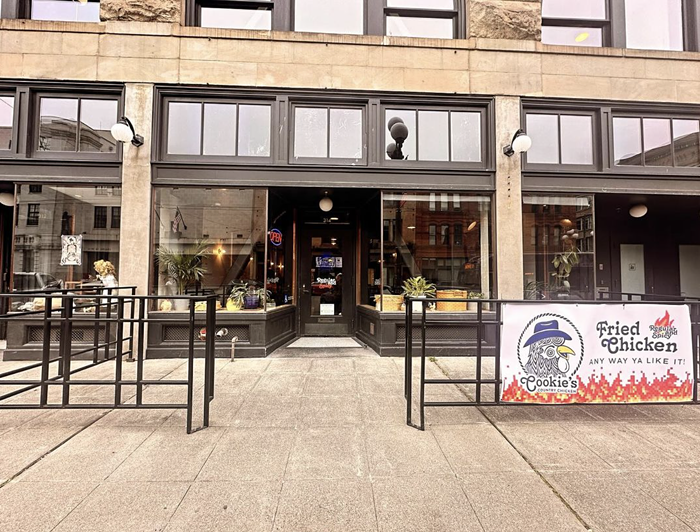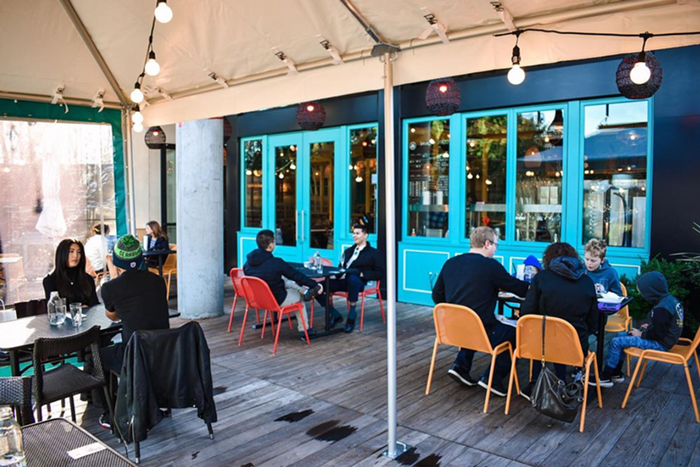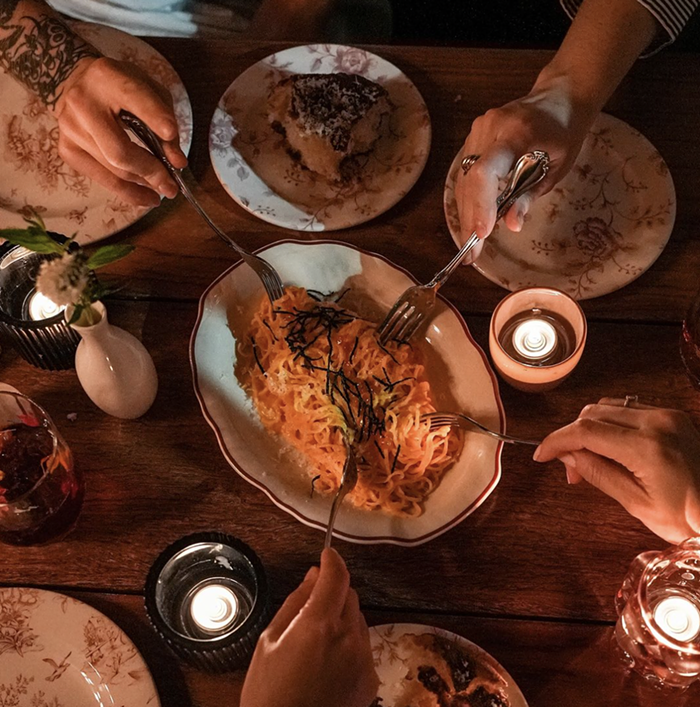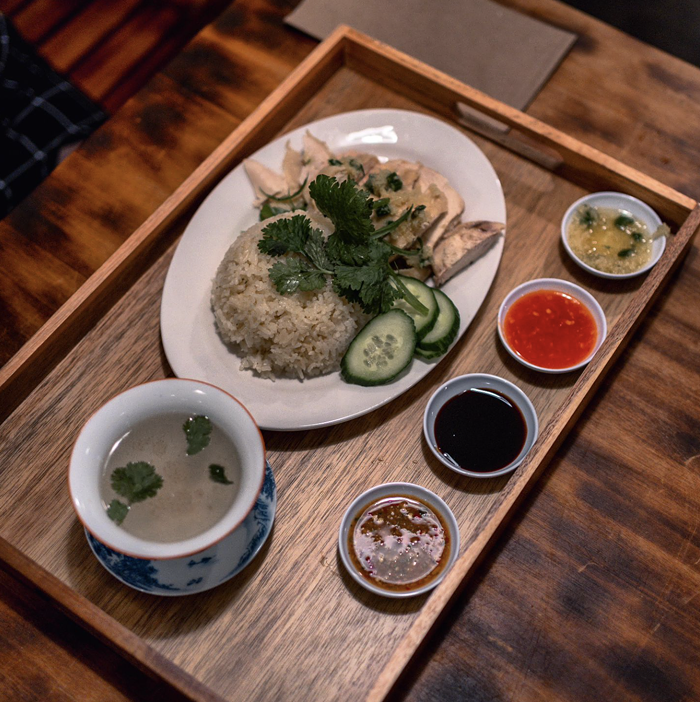
- Tobias Coughlin-Bogue
- The pozole features perfectly tender pork and just the right amount of hominy. But the real highlight is the house-made chili oil that comes with it. I'd splash it on my toothbrush.
When I got wind of Communion, Monica Dimas’s pop-up “Mexican Hangover Brunch” that’s running on weekends throughout the month of December, I knew two things: I had to go, and I had to get legitimately shitfaced the night prior in order to do it justice. I’ve worked with Dimas throughout the years, and her food has brought me back from the brink before many grueling brunch shifts. So I was eager to see if her first professional attempt at curative cooking would be a success.
But first, to achieve a hangover of true potency, I used a classic technique: ingesting the entire spectrum of booze. Three fancy beers were followed in short succession by a Negroni, a glass of red wine, three Rainiers, and an ounce of port I’d stashed away for just such an occasion. What followed was the type of massive hangover in which one can only sit up in bed with mouth agape. My girlfriend arrived with coffee only to find me in a coma on the couch, staring dully out from behind my tangled mane. After an hour or so of coaxing, she managed to drag me into the car, and we were off.
When we got to Nacho Borracho, the pop-up’s Saturday location (Sundays are at the Rhino Room), I thought for a moment they'd called it off. The bar was nearly empty and there was nothing on their sandwich board to indicate that it was a go. But lo, on every table there was a little card listing the four items available for “Communion Brunch.” Why is it called Communion? Dimas ended up in church on a Sunday, and was inspired to offer her own take on salvation, albeit with more pork. At the Rhino Room, one can even get a signature cocktail—Vita espresso, Kahlua, tequila, and cream—that arrives with a cute little communion wafer.
Unfortunately, this concoction wasn’t available at Nacho Borracho. But a great, simple michelada (a beer cocktail) was. I wasn’t in the mood for the hair of the dog so much as the whole hide, so I ordered one immediately. The bartender was remarkably patient with my bleary mumbling—obviously she's had some experience dealing with people in altered states of consciousness. Service is simple: Order at the bar, and if you need extra sauces or more water or cups of beer and spicy tomato juice, you get off your ass and ask the bartender.
I had been dead set on menudo, as it is the most traditional hangover cure in Mexico, and, like most modern food enthusiasts, I'm reflexively down for odd meats. But I was sidetracked by a different menu offering: vuelve a la vida (Spanish for “return to life”), a veritable cornucopia of seafood in briny broth, with so many different ocean creatures in it that I felt I would be remiss not to order it. My girlfriend went with the pozole, and we sat down to resume our game of dominoes while we waited for our soup. After a few hands, our dishes arrived on cute plastic lunch trays. The soup was served in simple plastic bowls along with slices of lime, thinly sliced jalapeños for the vuelve, and freshly made chili oil for the pozole.
If they made an #ifiwon Lotto billboard about my life, it would be me paying Dimas to come to my house and make this chili oil every morning so that I could splash it on eggs, in Bloody Marys, and probably even on my toothbrush. It's that good. It has plenty of bracing heat up front, but reduces to a low, lingering burn that lets the food shine through.
As for the food, it wasn't the best example of Dimas’s cooking I've ever tasted. Which is not to say it wasn't delicious. The pozole needed a bit of salt—though the broth was tangy, complex, and innards-warming—and the vuelve fell a little bit flat despite its staggering amount of clams, mussels, scallops, shrimp, and squid (for a mere $13).
Dimas is an excellent chef, so even a dish she's still figuring out is pretty amazing. Both the pozole and the vuelve were topped with a fresh slaw of diced onion, shredded cabbage, and a handful of cilantro, which gave them good textural balance. The pozole, when seasoned to my taste, was great. The pork was perfectly tender, pulling apart to blend in with the supple hominy—of which there was neither too much nor too little. And the vuelve had its highlights—including a mussel the size of a cell phone that I used to scoop up a pile of slaw, squid slivers, and jalapeño. Both dishes were served with crisp tostadas for scooping, dunking, or crumbling.
After eating I went over to talk to Dimas. She conceded that the vuelve is still a work in progress and that the menu should probably warn people that it’s served cold. But that's the best and worst thing about pop-ups: You're getting to eat experiments, not dishes that have been made for thousands of diners before you. "You figure things out over time," she said, and that's why Dimas is running her pop-up for a whole month, as opposed to one day. There are two weekends left, and it's only going to get better.
Given that it's boozy holiday party season, it's likely you'll have a hangover on one of those weekends. As a hangover cure, Dimas’s experiment is a success: At 6 p.m., I was at work, feeling surprisingly clearheaded and jovial as I poured pitcher after pitcher of beer for just such a holiday party.
